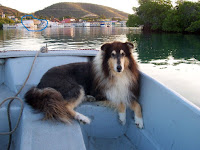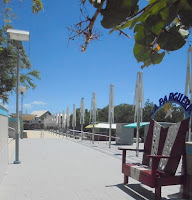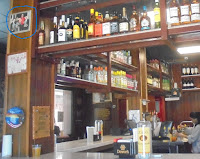The next part of my recent vacation to Puerto Rico was revisting La Parguera, the town where I lived from 1998-2009. Named for the local Pargo, or Snapper, this sleepy little town came to life in a big way on weekends.
Ruff Life (originally named King Tut) hit the shores of Puerto Rico in early 1998, following a grueling winter cruise down from Florida. There she is - the little trawler in the far distance, with Johnny's fleet of rental boats.
Each morning I'd dinghy Czar to shore for his walk, since most times I was the first one up. In the beginning we'd have to tie the dinghy to the mangroves or some out-of-the-way spot, hoping it wouldn't disappear or make anyone mad. I didn't know it at the time, but that sort of thing rarely happened in Parguera.
Lucky for us, shortly after arriving we became friendly with one of the dock owners (related to my boss at the time). They owned a beautiful power boat, which was docked right next to the Plaza (circled behind Czar, sweet boy).
Joe and Pat allowed us to tie the dinghy to their private dock shore-side (left), and also fill our water containers at their inside private dock, a real Godsend. I'd load Czar back into the dinghy, putter to the other side, tie up, fill one or two 5-gallon jugs, load the containers down into the dinghy, and head for my next chore. This became my morning routine, you should have seen my arms.
After a time Joe and Pat extended these priveleges to other visiting boaters. There weren't that many passing through, so I typed up a paper describing where to tie up, get water, buy groceries and find boat supplies; and one of us would dinghy a copy over to newly anchored boats. A real welcoming committee for a number of years; we even lent some our car. Met lots of great people.
But towards the end, Joe and Pat began complaining to us about the behavior of other boaters (filling up when J&P were entertaining; not leaving any space along the dock); you know, good things get ruined. OUR generosity was being tested. As you see, at some point after I left Puerto Rico, dock access was shut off completely.

Off the dock was this gravelly area (left, with Czar and a painted yola). At the far end of the path were Johnny's Boats and Carmen's Shell Shop, often overlooked from the Plaza.
The little wall separated the Plaza from the water. Because of the numerous reefs offshore, storms and hurricanes produced very little storm surges; I think Hurricane George produced 18", still lower than developed land. At any time of day there were usually some of the dock-guys hanging around or sleeping it off; I knew most of them, harmless. They always helped me tote my groceries.
I'd invariably meet Johnny, reading his newspaper while making sure his employees weren't letting any tourists pass by without a pitch. Always gave Czar a pat. We'd speak a few words, and oddly enough I'm realizing now that I think I saw Johnny more often than anyone else on the island.
A couple months after our arrival, the Captain hired Johnny's only son to drive Ruff Life to the nearby Bioluminescent Bay for my surprise birthday party, that was a wild time. Unfortunately, a couple years later, 'Junior' was killed during a San Juan club shooting, hard on Johnny, of course. His two daughters, younger than me, stepped in to help their Dad with his business.
I was therefore happy for Johnny when, last month, I saw his renovated dock and updated business, renamed Gina's, after his oldest. His fleet now includes a glass-bottom boat, competition for the popular, two-tiered Fondo Cristal, which held the monopoly the entire time I lived there. Johnny wasn't around so I asked one of his workers about his family.
"Gina died 3 months," he told me in Spanish. Mi Espanol isn't great so at first I thought he meant Johnny had died and Gina took over; but no, Gina died from cancer several months earlier. That was a shock, young woman. My heart sank for Johnny.
 |
| Plaza 2009 (a) 2023 (b) |
What else was different? I was almost afraid to find out. Next stop was Kuko's El Karacol restaurant and bar, located at the far end of the Plaza. It opened early, and each morning scraps from the day before were fed to the resident Satos (stray dogs).
As you can see, the Plaza has changed. The little concrete wall has been torn down, along with the trees, so that the pedestrian area extends to the water, erasing the gravelly area. No dock-guys hanging around here, and everything seemed blindingly bright to me.

The exterior of Kuko's has had a facelift, but the inside remains pretty much the same. None of this concrete was there.
 |
| El Karacol 2008 |
"Kuko sold it years ago," the bartender told me as she mixed my Mojito. While I waited I looked around the place, happy to see that Kuko's revolutionary decor was still on the walls.
Trained as a Chef in Paris, Kuko offered a different lunch special every day, delicious stuff; but he was best known for his Sangria Coño, depicted on the cup on the roof.
Early on he'd asked me to paint his logo on a cup-shaped plywood billboard, but I just couldn't paint a huge COÑO when I was trying to become a serious artist. If you don't know, coño is a bad word.
Just as well, for he went and bought the cup, much nicer. I asked for my Mojito to-go and brought home the plastic Coño cup, in case I don't have one back in storage. (Photo: they've kept a photo of Kuko, in red shirt, top left corner)
A kind man, Kuko allowed an adventurous German woman, Erica, to hawk her jewelry outside of his bar (no charge) for the evening crowd, and she was making money hand over fist. Erica was backpacking her way around the world, alone, and along the way someone taught her to make jewelry. After that she had little trouble funding the next leg of her journey.
Erica stayed in Parguera for a month or so. She loved Czar and wanted a photo taken with him, as did TONS of people who visited Parguera. I always regretted not charging a nickel a photo; could have made a fortune. Never heard from Erica after she moved on, but I still have a necklace she gave to me.
Here's Bobbie, a single-hander who lived on a teeny sailboat in Parguera for a couple years. She'd learned how to create incredible, galaxy-looking art using spray paint, fascinating to watch. She, too, set up in the Plaza, and also made good money. It was a funky-little place, but I don't think either woman would have the same opportunities now.
I was glad to see that the Reef Pop Restaurant was still open. I loved to eat bacon and eggs on their little first floor balcony, an infrequent treat. They've certainly expanded their outdoor seating, below.
I found myself twirling around, trying to orient myself. It all looked same-but-different. I was wandering alone with my memories, and as snippets shot through my brain like electric sparks, I was surprised at how calm and disconnected I felt. Did I really used to live here?
Parguera is the weekend playground for the island's wealthy, who have second and third homes on the outskirts of town. Parguera had, and pretty much still has, only 2 or 3 main roads to get around. This one-way was particularly annoying if coming from the west - you had to drive ALL the way around the older part of town...
...unless you felt like playing 'chicken' and tried to slip through going the wrong way. If you started but saw someone approaching, you could duck up into the Dive Shop's parking lot, I did that more than once.
Everywhere I looked showed progress. Less street parking, more outdoor seating. Looks like they've added a third story to Los Balcones bar and pool hall, on the right side of the street. I'll bet it's for extra standing and dancing during weekend festivities.
Heading back towards the dock, you leave the street and cut through the Plaza. This photo of me walking Czar was taken from the second story of Los Balcones, across the street. I love this shot; it sums up the time in a moment. The blue circle on the upper right side is where Ruff Life was anchored, but swinging in the wrong direction at the time of the photo.
I had no idea this photo existed until one night, heading home from the kite shop and working my way through the crowded Plaza (with Czar parting the way), this guy comes running up to me, all excited, and drags me over to his table, where he was selling 8x10" copies for $10 each. I had to buy this one, I thought that was pretty crappy of him, but I wanted the photo.
Artesans would set up tables in the Plaza; I did, too. Here's Alberto, one of my partners from our old gallery, Cayo Caribe, hawking his jewelry. I was shocked to learn that he, too, passed away several years ago, everyone thought I knew. There are still some people selling things in the Plaza, but much of it looks mass-produced. The Artesan world has changed, I was told more than once, so I guess I was in the right place at the right time for that, too.
THIS is what the same area looks like now. I couldn't figure out exactly what I was looking at. More than one person told me they don't go downtown anymore, I get it. I'm sure it's still packed on weekends, great for business owners, so I'm happy for them.
And finally, Carmen was a friend, my nearest neighbor and owner of the local shell shop, who taught me everything I know about seashells. She grew up in the Caribbean and lived for a time in Belize, where her father worked doing something-or-other. She'd talk about the quality of her Dad's shell collection, now packed away in her attic (like we do).
Carmen had a little deck behind her shop, which held a wicker loveseat, a couple plastic chairs, large TV and a chest-freezer. She commutes back and forth across the canal to her darling caseta (see photo, empty Plaza). Carmen let me keep my frozen food in the freezer, next to her freshly-caught Queen conch shells (the animal slips out when defrosted), so after I filled up with water, I'd dinghy over to her dock and pick up something for dinner before heading back to the boat.
Carmen turned the shop over to her daughter, who does a brisk business now, for it carries T-shirts and water-sport kitch; and her son-in-law runs his own tour boat company.
The shop still has some shells for sale, but Carmen told me she hardly goes out anymore because the water's over-crowded with boats; plus the shelling isn't as good as it was. Higher sea levels mean the reefs are less exposed (my favorite places to find empty shells), plus there's less resistance to storm surges.
"The Plaza flooded during the last hurricane; first time EVER," she told me as we sat on her back deck. It took out her little deck, and mud oozed up through the shop floor.
Blame it on climate change or not, here's another example of the Earth changing, and not for the better. This photo shows Elkhorn coral plentiful back in 2001, but gone by 2004.
So that was my morning routine, revisited. Parguera has changed even more, but this is longer than I'd intended, so to be continued...
To read from the beginning:
Reconnecting with Puerto Rico
Reconnecting with Puerto Rico




























I love this reportage on then and now in your great style. Bittersweet for sure. I am so glad you got to go back. I am with sister on maui for a week. Enjoying aloha time together Xx
ReplyDeleteThanks! Enjoy YOUR time away from the snow. xx
ReplyDelete